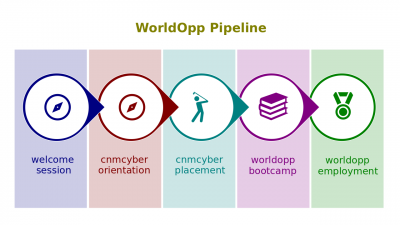Difference between revisions of "Educational Institutions"
(→Script) |
|||
| (13 intermediate revisions by 2 users not shown) | |||
| Line 1: | Line 1: | ||
[[Educational Institutions]] (hereinafter, the ''Lectio'') is the second [[lectio|lesson part]] of the '''[[Certifications of Study]]''' [[lesson]] that introduces its participants to [[educational service provider]]s and related topics. | [[Educational Institutions]] (hereinafter, the ''Lectio'') is the second [[lectio|lesson part]] of the '''[[Certifications of Study]]''' [[lesson]] that introduces its participants to [[educational service provider]]s and related topics. | ||
| − | [[File:Educaship-pipeline.png|400px|thumb|[[WorldOpp Pipeline]]]]This ''lesson'' belongs to the [[Introduction to Education]] session of | + | [[File:Educaship-pipeline.png|400px|thumb|[[WorldOpp Pipeline]]]]This ''lesson'' belongs to the [[Introduction to Education]] session of [[EmployableU Concepts]]. |
==Content== | ==Content== | ||
| − | The predecessor [[lectio]] is [[ | + | The predecessor [[lectio]] is [[Academic Credentials]]. |
| + | |||
| + | ===Script=== | ||
| + | :An [[educational institution]] is an [[enterprise]], usually an [[organization]] or its constituent part, that exists to provide the public with [[education]]. | ||
| + | |||
| + | :[[Preschool]]s offers early childhood education to children before they begin [[compulsory education]] at [[primary school]]. They also known as [[nursery school]]s and [[kindergarten]]s. | ||
| + | |||
| + | :[[Elementary school]]s or [[primary school]]s offer initial or primary [[compulsory education]], in the [[United States]] and [[Canada]], from the age of about seven to twelve. Students usually attend [[elementary school]] after [[preschool]] and before [[secondary school]]. | ||
| + | |||
| + | :In the [[United States]], a [[secondary school]] is a combination of [[middle school]] and [[high school]]). | ||
| + | |||
| + | :[[Tertiary school]]s are [[college]]s and [[university|universiti]]es that facilitate [[learning]] beyond [[compulsory education]] and awards [[academic credential]]s higher than [[high school diploma]]s. These ''schools'' are also known as [[post-secondary school]]s. | ||
| + | |||
| + | :Finally, [[vocational school]]s facilitate [[learning]] beyond [[compulsory education]], but does not award [[academic credential]]s higher than [[high school diploma]]s. Instead, [[vocational school]]s concentrate on those [[occupation]]s that do not require advanced [[academic credential]]s and those [[KSA]]s that are needed to start working in those [[occupation]]s. These ''schools'' can also be called [[trade school]]s, [[career center]]s, or [[vocational college]]s. | ||
===Key terms=== | ===Key terms=== | ||
| − | : | + | :[[Educational institution]], [[preschool]] ([[nursery school]], [[kindergarten]]), [[elementary school]], [[secondary school]], [[tertiary school]] ([[college]], [[university]], [[post-secondary school]]), [[vocational school]] ([[trade school]], [[career center]], or [[vocational college]]) |
| − | + | ||
| − | + | ===Closing=== | |
| − | + | :Is the difference between [[tertiary school|tertiary]] and [[vocational school]]s explained well? --Yes/No/I'm not sure | |
| − | |||
| − | |||
| − | + | '''[[Credentialing Bodies]]''' is the successor [[lectio]]. | |
| − | |||
| − | [[ | ||
| − | |||
| − | |||
| − | |||
| − | |||
| − | |||
| − | + | ==Questions== | |
| − | == | + | ===Placement entrance exam=== |
Latest revision as of 20:50, 29 October 2023
Educational Institutions (hereinafter, the Lectio) is the second lesson part of the Certifications of Study lesson that introduces its participants to educational service providers and related topics.
This lesson belongs to the Introduction to Education session of EmployableU Concepts.
Content
The predecessor lectio is Academic Credentials.
Script
- An educational institution is an enterprise, usually an organization or its constituent part, that exists to provide the public with education.
- Preschools offers early childhood education to children before they begin compulsory education at primary school. They also known as nursery schools and kindergartens.
- Elementary schools or primary schools offer initial or primary compulsory education, in the United States and Canada, from the age of about seven to twelve. Students usually attend elementary school after preschool and before secondary school.
- In the United States, a secondary school is a combination of middle school and high school).
- Tertiary schools are colleges and universities that facilitate learning beyond compulsory education and awards academic credentials higher than high school diplomas. These schools are also known as post-secondary schools.
- Finally, vocational schools facilitate learning beyond compulsory education, but does not award academic credentials higher than high school diplomas. Instead, vocational schools concentrate on those occupations that do not require advanced academic credentials and those KSAs that are needed to start working in those occupations. These schools can also be called trade schools, career centers, or vocational colleges.
Key terms
- Educational institution, preschool (nursery school, kindergarten), elementary school, secondary school, tertiary school (college, university, post-secondary school), vocational school (trade school, career center, or vocational college)
Closing
- Is the difference between tertiary and vocational schools explained well? --Yes/No/I'm not sure
Credentialing Bodies is the successor lectio.
